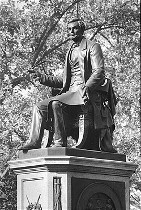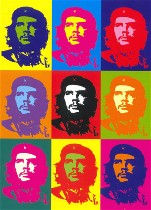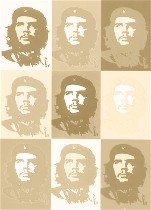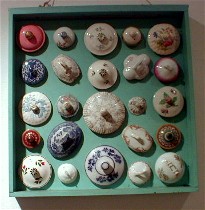 Art is a form of fiction, with the past or even the present seen through the prism of the artist’s eyes.
Art is a form of fiction, with the past or even the present seen through the prism of the artist’s eyes.
A mural, an exhibit and some web-transmitted art have brought me to these thoughts. I guess I’ll start with the mural, because that’s where I started looking.
I pass the mural “Thank you, Mr. Blackwell,” at 42nd and Haverford the side of the Terry Funeral Home (how apt, given that the mural is a memorial), at least twice a week. It’s by mural program regular Peter Pagast with Delia King and Larissa Danowitz.
The late Lucien Blackwell, a former city councilman, U.S. congressman and union leader whose councilmanic seat is now occupied by his wife, Jannie, was a big presence in a local way, a guy whose motto to his district was service.
The mural pretends toward history, with its photographic quality and its Photoshop collaged imagery. The cursive inscription “Thank you, Mr. Blackwell” on the bottom is straight out of a sentimental photo album.
But is it art? I don’t think so. It’s a mural that fits the preconceptions of the non-artists —Jannie? The Terrys? whoever–who wanted a mural dedicated to Lucien. The piece is smarmy. All I see is the perspective of Photoshop and the patrons, not the point of view of the artist.
 Certainly, memorializing history is traditionally public art’s domain (shown, Randolph Rogers’ Abraham Lincoln, in Fairmount Park), and the powers that be get to write that history, commission it, control it. But ultimately, it’s the artist who must make the art decisions for it to pass as art.
Certainly, memorializing history is traditionally public art’s domain (shown, Randolph Rogers’ Abraham Lincoln, in Fairmount Park), and the powers that be get to write that history, commission it, control it. But ultimately, it’s the artist who must make the art decisions for it to pass as art.
So now we have Lucien Blackwell handsomely painted into our memories in the most prosaic of ways. Mistake.
I want to protest the Photoshop collages, lacking a spatial context, that seem to be going up all around the city in a surfeit of pop culture blandness.
Personal history
In contrast, Brian Wallace, gallery director at Moore College of Art, sent along a couple of links to something called “Baghdad Journal” by Steve Mumford, an illustrated – by ink and paper – memoir that ran in a couple of issues of Artnet.com.
Accustomed as we are to photos, the travel art shocks with its personal and poetic views—a little Victorian and British, and the antithesis of photography.
I’m left wondering why someone is making this art at this time. But the images’ emotional and romantic sense of unfamiliar places and unfamiliar garb jump at me and slow my eye down. I understand that it’s unfair to compare these drawings to ordinary travel snapshots and photojournalism. But that’s what they seem to be competing with, and in that competition, they’re winners.
Are the inked memories more accurate or less accurate? Beats me.
Photo-processing for truth?
 But on the subject of accuracy and photos, I was in Quaker photo Tuesday, and got into a conversation about veracity and photo developing.
But on the subject of accuracy and photos, I was in Quaker photo Tuesday, and got into a conversation about veracity and photo developing.
Now, as we all know, the world has gone digital, and the Quaker lady was complaining that what comes in is totally changeable (shown, Andy Warhol’s Che, and Libby’s antiqued version, thanks to Photoshop), which is of course the great advantage and disadvantage of Photoshop.
 So in the process of trying to correct things, there’s not much way for the Quakers to know if what they’re doing is correcting or remaking altogether. What’s reality? At least a negative was a negative. At least it gave the illusion of reality.
So in the process of trying to correct things, there’s not much way for the Quakers to know if what they’re doing is correcting or remaking altogether. What’s reality? At least a negative was a negative. At least it gave the illusion of reality.
If this is memory, please give me fiction.
 Which brings me to the third show. I, and the rest of my neighborhood, remember poet and local historian Ruth Molloy with great fondness and admiration. So when the University City Arts League put up an exhibit called “The Art of Ruth Molloy,” I trucked on over.
Which brings me to the third show. I, and the rest of my neighborhood, remember poet and local historian Ruth Molloy with great fondness and admiration. So when the University City Arts League put up an exhibit called “The Art of Ruth Molloy,” I trucked on over.
To call this an art show was deceptive. It was an estate sale–and a depressing one at that, because Molloy was a collector of street debris and trash, some of which she organized in groups (shown, tea pot lids which are memories of the broken teapots, no doubt), some of which she used as a jumping off point for poems or observations (shown, a crushed soda can and the thought it inspired), and some of which she just left hanging around, waiting for their moment of inspiration.
 The show included some digital prints on watercolor paper of her photos. So the photos weren’t even authentic. They were copies. As for their staying power, the label said the paper was archival, but it didn’t say if the ink was.
The show included some digital prints on watercolor paper of her photos. So the photos weren’t even authentic. They were copies. As for their staying power, the label said the paper was archival, but it didn’t say if the ink was.
Anyway, I prefer to remember Molloy for her spark of life, not for the remnants of her creative process.
This makes me sad, especially because with my parents’ deaths in the past two years, I realize more than ever how special each of us is, and how ephemeral we are, lasting in three dimensions only in the memories of those who loved us.
Photoshop cannot adequately capture us.









